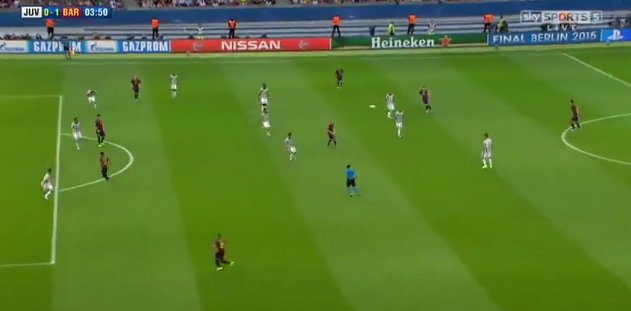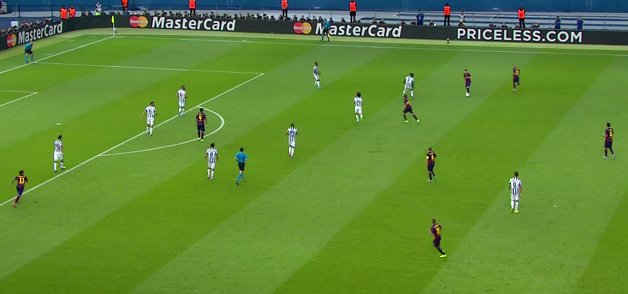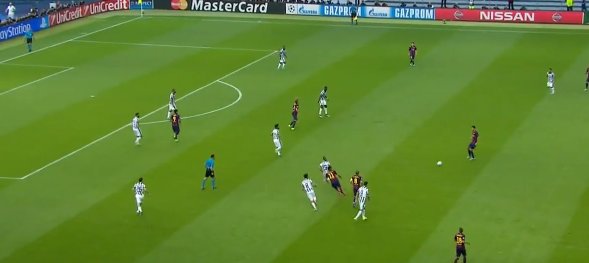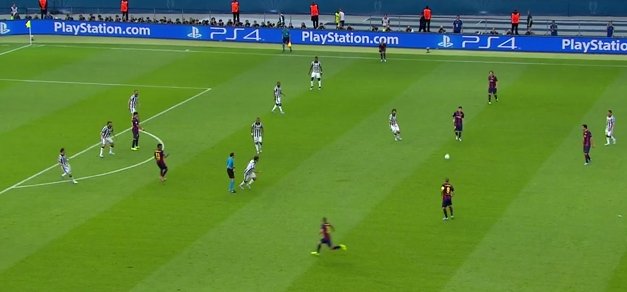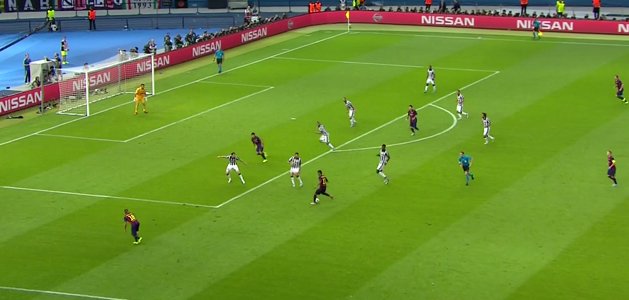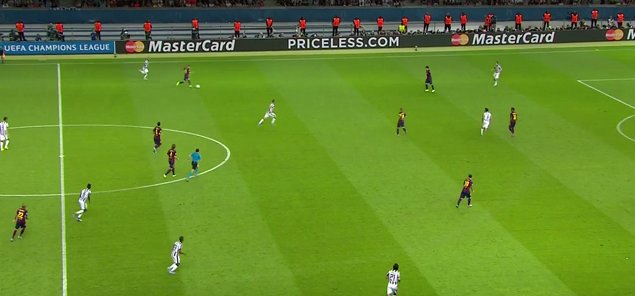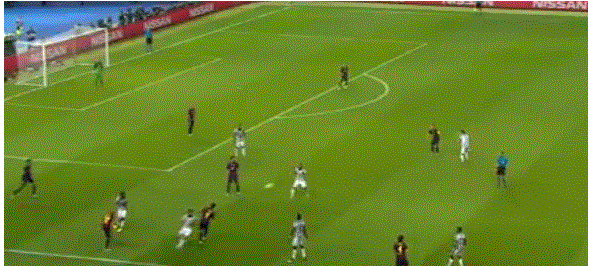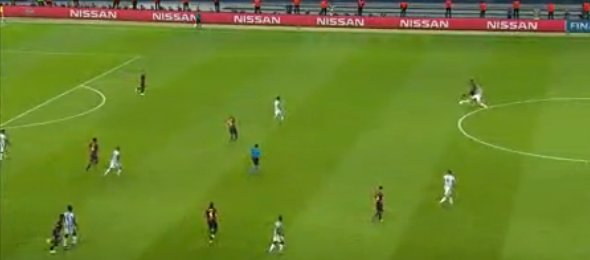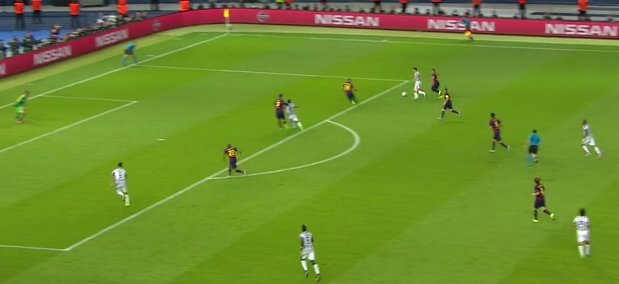By Stevie Grieve
Overcompactness
Vulnerable to the switch of play especially Messi-Neymar or Alba on the left
Barcelona exploit this via switching play to Neymar / Jordi Alba
The biggest problem with Juventus playing closer to the left side (Messi’s side) and compacting the space is that the defensive and midfield chains get dragged across to cover for each player moving across, resulting in a lack of protection on the far side.
Often Neymar would drag Liechtsteiner inside, while Jordi Alba made late runs from deep and exploit the space 2v1. The 1st goal comes from this, resulting in Bonucci being drawn across to deal with Neymar while Vidal failed to track Iniesta who passes to Rakitic for the opening goal.
Here, we can see the ‘front 3 (Rakitic in place of Messi) with Suarez and Neymar inside. Jordi Alba arrives late and causes Liechsteiner a problem as he goes to deal with Alba, drawing Bonucci over to track Neymar.
We can see this time that the space around Messi is closed for any diagonal 1-2 passes but the switch of play is open – he can look for the pass behind the defence into the run of Neymar (which has been seen and resulted in goals all season) while Alba stretches the play from a deeper position on the left side.
As Neymar stays wide, Liechsteiner is now no longer making chain movements with Bonucci as the overcompactness has been exploited too many times, so his position is adapted to close down the switch of play 1v1 much earlier. Here, Messi can use Iniesta then Alba can run late (out of image) to play 2v1 with Neymar as Marchisio will be dealing with Iniesta in a central position.
On the left, Neymar’s willingness to run into tight spaces draws the attention of several players which overcompacts the side of the ball and leaves Busquets free to find Messi in his most dangerous zone which Juventus did well to block for the 1st half.
Struggle to deal with Alba deep runs
With the ability of Messi to find passes through the midfield line or behind the defence or to switch play to the left side to Neymar, means that the far side full back and wide midfielder are tucked in to stop the short passes, which means that when Neymar drifts inside, Jordi Alba can run free, A natural consequence of playing a narrow 4-4-2 diamond is that the full backs have nobody directly against them. In Barcelona’s attacking system of 2-5-3 or 2-4-1-3, the full backs were key to numerical superiority and accessing the wide areas to stretch the Juventus defence.
Here we can see Neymar inside looking for the diagonal pass from Messi with Jordi Alba running late onto the outside as Iniesta receives to stretch the play wide while Neymar can offer a pass through the channel for the combination into the front.
As Neymar drifts inside and receives in the channel, Alba is wide and unable to be engaged in a 1v1 if Neymar passes wide. As Juventus have no set ‘midfielder’ there is a common 2v1 on the left side.
This time, Barcelona are on the counter-counter attack and Jordi Alba is the player attacking the space left by Liechtsteiner as the Juventus Full Backs adapted to attack more in the 2nd half.
Changes to the defensive process in the 2nd half; Neymar tracked deeper and pressed higher
In the 2nd half, as Juventus were more adventurous in their attacking play, Leichtsteiner often came out of the defensive line to close down Neymar as he dropped deeper to take the ball and run inside with it (as he did against Bayern Munich away for the 1st and 2nd goals). Liechtsteiner tracked him deep and played 2v1 against him with Marchisio who would adapt his position to play higher and close off the space of Jordi Alba in the channel in a pre-transition space.
A part of the Juventus attacking process was to press high then force Barcelona into taking throw ins, which would be switch across the field, providing Juve a chance to press high up on the far side and win the 50-50 ball. On 3 occasions, Dani Alves switched play from right to left from a throw in return pass, the 3r resulting in a turnover form an aggressive press and a direct attack at goal.
2nd half; Attacking Full Backs
A part of the Juventus attacking process was to press high then force Barcelona into taking throw ins, which would be switch across the field, providing Juve a chance to press high up on the far side and win the 50-50 ball. On 3 occasions, Dani Alves switched play from right to left from a throw in return pass, the 3r resulting in a turnover form an aggressive press and a direct attack at goal.
Dani Alves takes a return pass but is forced to clear the ball – instead clearing it towards Neymar in a switch of play which is pressed by Liechsteiner in a deeper position then he reached in the 1st half, leading to a turnover then a goal from a cutback by Liechtsteiner in his first venture into the box.
[wpsharely id="2988"][/wpsharely]Jordi Alba rushes out to press and the backheel beats him, allowing Liechsteiner some space to attack the box.
Tevez drops short as the ball is cutback, spins and has a shot saved, which is turned home by Morata at the back post (Alves leaves him to press Tevez with his back to goal).
By Stevie Grieve. (Follow on Twitter @steviegrieve) Stevie is also the author Coaching the 4-2-3-1, Coaching the 4-2-3-1 Advanced Tactics and From Futsal to Soccer

